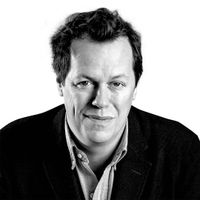'Monolithic, multi-layered and quite, quite magnificent. This was love at first bite': Tom Parker Bowles on his lifelong love affair with lasagne
An upwardly mobile spaghetti Bolognese, lasagne al forno, with oozing béchamel and layered meaty magnificence, is a bona fide comfort classic, declares Tom Parker Bowles.


It started with a cat — fat, orange and indolent — by the name of Garfield. The star of an eponymous American cartoon strip in the 1970s and 1980s, I remember little of him, save a limitless appetite for something called lasagne. I had no idea what the dish was or even how it was actually pronounced. The drawings didn’t offer much to go on, simply a baking tray filled with something brown, divided into lots of squares, but if Garfield liked it, then so would I.
As I hounded my mother for a taste of this mysterious dish, las-ag-nn became an obsession. When I finally got to try it, at my aunt and uncle’s house in Dorset, I was both delighted and underwhelmed. For far from being some fragrantly exotic melange, it was just upwardly mobile spaghetti Bolognese. Albeit monolithic, multi-layered and quite, quite magnificent. This was love at first bite.
I’m not alone in my adoration. It’s a bona fide comfort classic, a once humble dish that now bestrides the world like a béchamel-topped Colossus. Named after the variety of pasta used to make it, lasagne al forno soothes, satisfies, delivers and delights. Although, be warned, it’s a recipe that seems to use not only every pot in the house, but every implement, too. My advice is to wash as you go, because this is not so much a dish as an epically joyous construction. You want a thick, silken béchamel that oozes into that ragù sauce, all slow-cooked succour. As the latter blip-blips gently away, I gaze into its limpid brown depths, lost in meaty reverie.
It’s not all about the meat, however. You can make it with mushrooms, truffles or pesto, as they do in Liguria in north-west Italy, where it’s known as mandilli de sae al pesto in Genoese, or ‘silk handkerchiefs’, thanks to the gossamer thinness of the pasta.

The celebrated house lasagna with beef at Le Fer à Cheval restaurant in Verbier, Switzerland.
Talking of pasta, although the late Italian cookery writer Marcella Hazan may not have approved, good quality shop-bought is fine. By all means, get jiggy with the pasta machine, but it’s certainly not essential. I finish my lasagne with a layer of béchamel and a lusty grating of Parmesan, as in the recipe below, a classic I return to again and again. Nigella Lawson adds mozzarella, too — a rather inspired flourish.
If anything remains, simply reheat a fat portion in a hot oven — the edges will get gloriously crisp and crusted.
But this is lasagne — and the chances of any left-overs are very slim indeed.
Exquisite houses, the beauty of Nature, and how to get the most from your life, straight to your inbox.
Ingredients
Serves 6
For the ragú:
- 2tbspn olive oil
- 125g rindless streaky bacon (or pancetta), chopped
- 1 large onion, finely chopped
- 2 garlic cloves, finely chopped
- 3 medium carrots, peeled and finely chopped
- 2 celery ribs, peeled and chopped
- 500g best-quality beef, minced
- 200g chicken livers, picked over and finely chopped
- 400g can of chopped tomatoes
- 1tbspn tomato purée
- 2 glasses red wine (about 300ml)
- Salt and black pepper
- 2tbspn fresh basil, chopped
- 2tbspn flat-leaf parsley, chopped
For the bechamel:
- 1 medium onion, finely chopped
- 2 cloves
- 1 bay leaf
- 8 black peppercorns
- 1tspn salt
- 500ml milk
- 50g butter
- 50g flour
- 150ml double cream
- 9 sheets dried egg lasagne
- Large knob of butter
- Freshly grated nutmeg
- 2tspn Parmesan cheese, freshly grated
Method
1. To make the ragù, heat the oil in a spacious, heavy-bottomed pan and gently fry the bacon. Add the onion and let it brown slightly before adding the garlic, carrots and celery. Cook, stirring all the time, until the vegetables are beginning to soften, then add the beef.
2. Stir until the meat is evenly browned and then add the livers. When they have started to firm up, add the tomatoes, tomato purée and wine.
3. Season with salt and pepper and add the herbs. Simmer very gently for about one hour, stirring occasionally (use a heat-diffuser pad if you have one), until the sauce is richly flavoured and almost all of the liquid has been absorbed.
4. Meanwhile, make the béchamel. Place the onion, cloves, bay leaf, peppercorns, salt and milk in a pan. Bring to the boil and simmer for five minutes, then remove the pan from the heat, cover and leave for 15 minutes.
5. Melt the butter in a separate pan and stir in the flour to make a roux. Strain the milk into the roux and whisk thoroughly. Simmer for 10 minutes, then add the cream. Put it to one side.
6. Cook the lasagne, in boiling salted water with a splash of olive oil, until it is tender, taking care the sheets don’t stick together. Drain, then dry them on a tea towel.
7. Choose a fairly deep, wide earthenware or porcelain dish and butter it well. Assemble the dish by making layers, first with pasta, then ragù and then béchamel, continuing in this style until everything is used up, but finishing with a thick layer of béchamel. Dust the top with nutmeg, then cover it with a generous coating of Parmesan.
8. Pre-heat the oven to 190˚C/375˚F/gas mark 5 and bake on the top shelf for 45 minutes, until bubbling and blistered.
Tom Parker Bowles is food writer, critic and regular contributor to Country Life.
